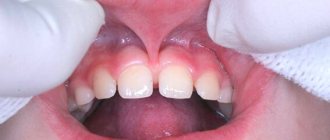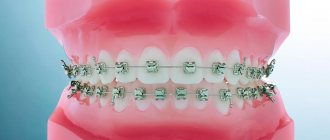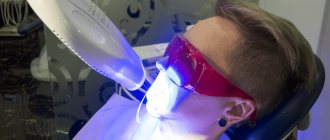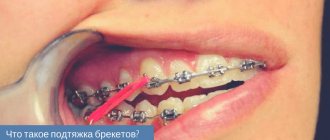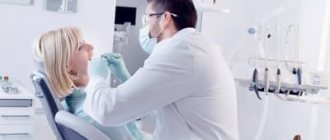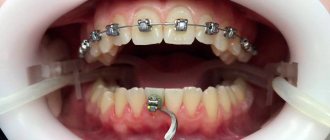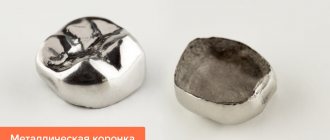05.08.2021 495
There are a large number of reasons why a person could potentially suffer such an injury. In this case, there can be a lot of unpleasant consequences - from a simple violation of aesthetics to severe pain, hypersensitivity to cold or hot food.
Let's look at why chips may appear and what the consequences are. We will also touch upon the issue of prompt home treatment in such a situation, as well as a method for solving the problem by a professional dentist.
The most common causes of chipped teeth
Human teeth are very strong. They are well protected from external mechanical influences and are designed specifically to cope with tough, fibrous foods. However, there are many factors that could potentially lead to chipping.
When you make an appointment with your dentist, he or she will conduct a thorough examination of your mouth and determine what may be causing the problem.
Typically, chips occur as a result of several common reasons:
- Inattentive food selection. You can chip a tooth when chewing if there is something too hard inside the food. It could be a small stone, a mollusk shell, and much more. The danger is especially great if you actively chew food and cannot sense in time that something is wrong.
- External trauma. Often happens when hit, fallen, or involved in a traffic accident. There is also a danger of collateral injuries. This may include tooth dislocation, gum damage, wounds on the tongue, or the oral mucosa.
It is also important to understand that the strength of a person's teeth may vary depending on many factors. There are several factors that significantly increase the likelihood of chipping:
- Violation of the acidity of the oral cavity.
- Enamel diseases.
- Cracks on the surface of the tooth.
- Severe damage to the seal.
- Malocclusion and other congenital deformities.
- Bruxism.
People with bad habits are also at risk. Excessive consumption of alcohol and smoking leads to teeth becoming much more fragile.
If a person belongs to a risk group, a chip may appear even from not the strongest pressure. Therefore, it is worth monitoring the condition of your teeth and taking timely measures. So, if you suffer from bruxism and grind your teeth a lot at night, you should choose mouthguards on the advice of your dentist to reduce the negative impact.
Some people also experience chipping simply because they are inattentive to their diet. They actively chew on candy and nuts and open their jaws too much while chewing food, which significantly increases the potential for injury.
Sometimes the problem takes on a systemic nature and indicates negative changes in the body, a lack of certain nutrients from food. In this case, the answer to the question of why teeth may break off specifically in your case is given by a comprehensive examination.
Fracture of dental crown with pulp exposure (D)(S02.52)
This type of injury occurs quite often in dental practice. In this case, point, partial or complete exposure of the pulp occurs, resulting in increased sensitivity of the tooth to temperature and mechanical influences. In this case, pain may often be absent, which is associated with damage to the neurovascular bundle. Immediately after injury, pinpoint hemorrhage and redness of the pulp may occur. The damage is characterized by extensive opening of the tooth cavity with or without disruption of its mobility. The treatment method is selected taking into account the time elapsed since the injury, the stage of root development, the degree of pulp opening and the general condition of the patient.
- For point injuries, biological therapy or vital amputation of the pulp is performed, followed by treatment with calcium hydroxide-based pastes and closure of the fracture line with glass ionomer cement.
- In case of a large area of damage, vital amputation of the pulp is performed and a pad of hydroxide-containing paste is applied. After 2-3 weeks, permanent restoration of the tooth is performed.
- For pulp necrosis, treatment involves multi-stage filling. Next, the root canal is obturated and the anatomical shape of the tooth is restored.
Signs of chipping
In most cases, chips can be identified by visual inspection or when the patient simply touches the tooth with his tongue. But there are also situations when the chip is located on the inside, difficult to reach and difficult to inspect.
Such situations reveal themselves as a whole list of symptoms. These include the following:
- Problems with chewing food, something constantly gets in the way, pieces begin to get stuck inside the tooth.
- The loss of a previously installed filling (a chip forms on the remaining part of the tooth and it simply cannot hold on normally).
- Severe sensitivity when eating - a reaction occurs to sour, salty, cold, hot foods.
- Acute pain and severe pulsation at the site of injury.
It is worth understanding that the size and nature of chips may vary. Because of this, some patients may not even notice the problem, while others experience severe pain - their nerve is exposed. Regardless of the degree of destruction, you should consult a doctor as soon as possible and conduct a detailed examination of the oral cavity.
When should you go to the dentist?
Immediately after receiving an injury, parents need to pull themselves together and try to calm the baby. The first thing you need to do is make a visual inspection, try to carefully clean the oral cavity from food debris, ask the child to rinse his mouth with boiled water at room temperature or a light antiseptic solution. To relieve the pain a little and reduce swelling, you can apply ice wrapped in several layers of napkins to the cheek on the side of the sore spot. If bleeding occurs, apply a piece of sterile bandage to the wound and immediately go to the doctor.
The first step is to ask your child to rinse his mouth.
Main types of damage
The choice of treatment method directly depends on how badly the patient’s tooth is damaged. There are several common manifestations, which include the following:
Crack in the enamel.
- The enamel itself is very durable, which is not surprising - it acts as the main protective mechanism throughout life. There are many factors that can lead to the appearance of microcracks in the surface. From the outside, they are often very difficult to distinguish, but they can not only increase in size, but also become the cause of common oral diseases, such as caries. Food gets packed into the cracked areas and bacteria actively multiply in them. At the same time, the strength becomes less and the likelihood of a large chip only increases. The standard cause of the problem is an incorrect diet, eating a lot of sweets.
- Chipping of part of the enamel. A lacuna appears on the tooth, which is often clearly visible even during an external examination. There is pain and an acute reaction when eating various types of food. It is worth consulting a doctor as soon as possible to prevent the problem from getting worse.
- Skol. It differs in location and size. Depending on the nature of the injury, it appears on both the external and internal sides of the tooth and is clearly visible during the initial visual examination. The injury is accompanied by hypersensitivity, severe pain, pulsation and other noticeable negative manifestations.
Injuries in which the tooth is chipped at the root are also common. They are the most dangerous for humans, because in this case the nerve is exposed and the patient begins to experience severe physical suffering. Further actions in case of injury will depend on the condition of the remaining part of the tooth. Removal of the root is required, but sometimes it is possible to use the remainder as a base for a crown.
In our clinic, doctors fight for every tooth. We do everything to restore aesthetics, chewing ability and relieve you of pain.
Crown fracture without pulp exposure with enamel damage (B) (S02.50)
In this case, the enamel chips, which is most often localized at the corners of the front teeth. Clinical manifestations of the injury include pain when exposed to heat and the possibility of cutting the tongue with sharp edges. Redistribution of the crown within the enamel is easily diagnosed during a visual inspection. The tooth maintains mobility within the physiological norm and demonstrates positive percussion. X-ray studies in this case usually show the preservation of bone tissue and roots, and an electrical excitability test shows the vital activity of the pulp. Treatment for chipped enamel is carried out as follows:
- rough and sharp edges are well ground and treated with fluorine compounds;
- enamel is restored using modern composite materials (fillings);
- Dispensary observation of the functional state of the pulp is carried out.
First aid at home for a chipped tooth
Sometimes the injury occurs late in the evening or it is impossible to make an appointment with a doctor the next day. In this case, you need to take the right steps to prevent infection, relieve pain, and rule out most other potential problems.
At home, several actions are taken depending on how severe your injury is and what signs it is accompanied by:
- Mouth rinse. Note that as soon as a tooth chips, you need to stop swallowing saliva until you rinse your mouth. Rinsing is done gently, without creating a vacuum or strong pressure on the affected side. To ensure quick disinfection, you can also use a chlorhexidine solution.
- Application of a special compress. This is necessary in order to minimize swelling. At home, use a towel soaked in cold water or a special ice bag, which we recommend keeping on hand. If there is no such bag, put the ice in a bag and wrap it with cloth. The same towel will work well.
- Taking painkillers. This allows for temporary relief of pain. If you do not have any contraindications, you can use products with an additional anti-inflammatory effect. These include such as Ibuprofen, Dolaren and others. When the patient does not have individual intolerance to drugs, and the chip is large, it is practiced to place a tampon soaked in lidocaine or novocaine inside. The measure is needed to significantly reduce pain and prevent pathogenic bacteria from entering the chipped tooth.
A special situation arises if a person experiences severe bleeding. In this case, rinsing is contraindicated. The tooth itself can be covered with a turunda for additional protection.
If you have a chip, you need to see a doctor as soon as possible. When a tooth is chipped at the root, we recommend saving the remaining part - it will be needed for subsequent restorative procedures.
It is not recommended to delay going to the doctor. The reason is that there is a high probability of infection and gradual further spread of the process.
Types of professional medical care
When a patient sees a dentist, he carefully assesses the situation. Depending on the initial state, there may be many options for action. These include:
- Remineralization. This method is used if a small crack occurs in the enamel. Either an individual tooth or the entire row can be treated with a special strengthening preparation. A special product is used, which contains a sufficient amount of various trace elements and minerals. The technology allows you to get rid of cracks and significantly strengthen the tooth.
- Application of preparations with a high fluoride content. This is also necessary in order to significantly improve the overall condition of the enamel. The patient is prescribed a special mouthguard, onto which such material is applied. This makes it possible to provide treatment around the clock.
- Artistic restoration. This method is needed specifically to restore the aesthetics of the oral cavity. The method is used if the chip is small. Modern technologies are needed to restore the shine of enamel. The color of the restored fragment will not differ from the surrounding row.
- Installation of additional cover. One of the most common methods of restoring dental aesthetics without the use of complex and lengthy operations. We use various types of overlays – these can be lumineers and veneers. The composition, duration of use, appearance and many other characteristics differ.
- Placement of a special crown. The approach can be used if the upper part of the tooth is not severely damaged. The remaining part of the tooth in this case begins to be used as a natural support. The crown will be stable and will completely fill the vacated space.
- Using special tabs. At the same time, the order for the production of such an onlay is transferred to a special dental laboratory. The overlay is very durable and restores chewing ability.
Sometimes, as a result of strong pressure, the tooth root itself breaks. This is the most serious situation in which proper removal of tooth remains and subsequent implantation will be required. A base is installed in the gum, on which a special crown is fixed.
Combined root and crown fracture with pulp exposure (E) (S02.54)
This type of injury has a high degree of complexity and is quite rare. As a result of its production, destruction of the crown and root into small fragments may be observed. The patient experiences bleeding in the pulp and periodontal areas, as well as in the fracture crevices. The severity and nature of the injury is determined using x-ray examination. The exact depth of the fracture can be determined after removing the broken tooth fragments. Treatment of combined fractures, affecting both the root and crown, usually involves tooth extraction.
Chip in the front row of teeth
Typically, such chips occur when biting or a strong blow. Even the smallest defects are noticeable on the front row, so a small chip can cause not only discomfort, but also psychological problems. Also, the aesthetics are spoiled by microcracks, which over time begin to turn black and become more and more visible.
When small cracks appear, fluoridation and mineralization are usually sufficient. If the enamel has been severely damaged and part of the tooth has broken off, installing an artificial veneer would be a good solution. In our clinic, your dentist will install veneers or ultraneers for you. If the damage is severe, the only option is removal, prosthetics or implantation.
Symptoms of cracked teeth
Even if the crack is located on the child’s front tooth, it is not always noticeable. The defect is visible when it is of significant depth and extent, as well as when it gradually stains. Only a dentist can notice the problem in the early stages.
In some cases, additional symptoms appear, the presence and severity of which depend on the depth and location of the defect:
- pain or discomfort at rest and/or when chewing food;
- increased sensitivity to hot, cold, sour, etc.;
- bad breath;
- local change in enamel color;
- inflammation of the gums in the area of the defect, their bleeding.
Chip on the side of the tooth
Most often occurs during chewing. Since this is a side invisible to prying eyes, many patients decide not to see a doctor at all and live with such a defect.
This approach is wrong for several reasons:
- A chip can easily become a site for the development of caries and the situation will only get worse.
- Due to the strong pressure on the damaged area, further destruction is possible.
- There is a risk of injury to the tongue when it comes into contact with a sharp edge and the onset of an inflammatory process.
The advantage of working with the sides is that aesthetics matter less. Therefore, you can get by with less expensive materials during the restoration process. The strength itself will not become lower.
Occurrence of a vertical crack
Sometimes a chip does not appear, but the tooth cracks vertically - this is very noticeable from the outside. The choice of treatment method will be based on how severely the enamel is damaged and how deep the crack goes.
There are three main treatment options:
- Standard filling.
- Installation of external onlays on the tooth.
- Removal and subsequent implantation.
It is important to resolve the problem quickly before numerous potential complications arise.
Do children need to treat chipped teeth?
Parents often ask the question of what to do if a child’s tooth chips. Many people believe that baby teeth are not that important and therefore need not be treated. The logic is simple - they will fall out on their own and be replaced by indigenous ones.
But you should not be guided by this logic for a simple reason - the condition of the baby tooth greatly affects the formation of the molar. The onset of the inflammatory process and infection of the tooth lead to inflammation of the gums. This can negatively affect the formation of permanent dentition.
Prevention of injuries to baby teeth
- If possible, stop the child’s attempts to try everything by heart.
- Teaching your child how to properly brush their teeth.
- Children's toothbrush with soft bristles.
- A nutritious diet with sufficient calcium and fluoride.
- Regularly remind your child about the dangers of chewing pens and pencils.
- Carry out deworming periodically, especially if there are pets in the house.
- Visit your dentist in a timely manner to correct your bite.
- Treat initial caries (at the spot stage) immediately.
- Have a dental examination every year.
If a child has a broken baby tooth, the dentists at the First Family Clinic of St. Petersburg will carefully examine and, if possible, restore the damaged crown. We guarantee excellent aesthetic results. Your child will quickly forget about the injury.
What complications can you encounter due to chips?
If you notice a chip on your tooth, you should contact your dentist as soon as possible to have it repaired. And it's not just about aesthetics. Delay will cost the health of your smile. There are several potential complications that have to be encountered in medical practice:
- Tooth infection. Any pathogenic bacteria can penetrate through the open pulp. As a result, the person not only suffers from pain. Previously, only a slightly damaged tooth that could still be saved had to be removed.
- Periodontitis. This is the name of a strong inflammatory process that occurs in the tissues surrounding the apex of the tooth root. Treatment is long and complex and may require removal.
- Formation of neoplasm. They can be of either granulosa or cystic type and pose a serious danger to the human body.
- Changes in bite and dental mobility. It is formed due to the fact that it becomes inconvenient for a person to close his jaws. There are many types of complications due to this reason.
The development of severe sensitivity to food, which over time develops into pain, is also characteristic. You cannot delay treatment - contact a doctor as soon as possible.
Crown fracture without pulp exposure with damage to enamel and dentin (C)(S02.51)
This type of damage is characterized by traumatic destruction of hard tooth tissues, which extends to enamel and dentin. A crown fracture can be either oblique, longitudinal or transverse. The injury is visually diagnosed by the absence of a significant part of the crown. The patient complains of pain when exposed to chemical or thermal effects, biting into hard food or touching a tooth. To assess the severity of damage, percussion, X-ray examinations, and electroodontic diagnostics are used. In this case, treatment of children's teeth involves covering the fracture line with a calcium hydroxide lining.
Next, the injured area is treated with special materials, which are selected taking into account the stage of development of the tooth root:
- When the length of the root and crown are equal, the damage is covered with a special bandage based on glass ionomer material and a temporary crown.
- When the root is actively forming, a compomer filling material is used together with a protective cement lining.
- At the last stages of tooth development, after treatment with glass ionomer cement, the defect is filled with modern composite compounds.
For large-area fractures, it is recommended to install a temporary crown followed by tooth restoration after 3-4 weeks of follow-up. If any complications occur, endodontic treatment is performed.
How to prevent chipping
There are several tips that dentists give to patients in order to keep their teeth intact for as long as possible. These include:
- Maintain good oral hygiene. Use high-quality pastes, rinses, special gels as recommended by your doctor. The enamel needs to be strengthened.
- Visit your dentist regularly. It is necessary to carry out proper dental treatment, to ensure that the enamel does not crack or wear off.
- Monitor the condition of the gastrointestinal tract and other body systems. Particular attention should be paid to the functioning of the endocrine and immune systems. Changes in the balance of acidity in the oral cavity should not be allowed.
- Form your diet correctly. It should include foods that stimulate strong bones and teeth.
- Correct your bite. Due to improper bite, chips appear quite often, and the enamel itself is worn away ahead of time. It is cheaper to get braces than to periodically spend money on veneers, implantation, remineralization and other dental procedures.
- Cure bruxism. This may require you to wear special mouthguards.
Equally important is the advice to monitor what and how you eat. Try not to chew on anything too hard—candy, nuts, and more. If you chew carefully and watch what you eat, the likelihood of chipping will be much less.
We will quickly and efficiently deal with chipped teeth
At our clinic, doctors are ready to quickly treat chipped teeth and any other injuries or damage. We use advanced techniques - from remineralization to installation of onlays and implantation.
We offer our clients affordable prices and are always ready to answer any questions they may have. We will relieve you of pain, restore the aesthetics of your smile and the ability to chew normally. We have affordable prices and special offers.
To learn more about the treatment process and make an appointment with a dentist at a convenient time, leave a request on the website or call us at the numbers provided.
